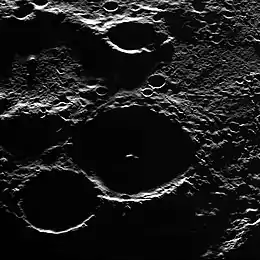 MESSENGER image with Tolkien at center. The north pole is on the rim of Tryggvadóttir, the crater at left foreground. | |
| Planet | Mercury |
|---|---|
| Coordinates | 88°49′N 211°05′W / 88.82°N 211.08°W |
| Quadrangle | Borealis |
| Diameter | 50 km |
| Eponym | J. R. R. Tolkien |

Processed image of the northernmost part of planet Mercury: this shows the temperatures at the North Polar Region, which ranges from >400 K (red) to 50 K (purple). Tolkien is on the left of the image.
Tolkien is one of the northernmost craters on Mercury, located in the Borealis quadrangle (north pole region) at 88.82 N, 211.08 W.[1] It is 50 km in diameter. It was named after the South African born British writer J. R. R. Tolkien. The name was approved by IAU's Working Group for Planetary System Nomenclature on August 6, 2012.[1] Since Tolkien is very close to the north pole, and Mercury has almost no axial tilt, Tolkien receives very little sunlight.[2] S band radar data from the Arecibo Observatory collected between 1999 and 2005 indicates a radar-bright area covers the entire floor of Tolkien, which is probably indicative of a water ice deposit.[3][4][5][6]

Radar-bright deposits near the north pole. Tolkien is above left of center.
See also
References
- 1 2 "Tolkien (crater)". Gazetteer of Planetary Nomenclature. USGS Astrogeology Research Program., accessed 19 February 2019
- ↑ "Permanently Shaded Polar Craters". NASA/Johns Hopkins University Applied Physics Laboratory/Carnegie Institution of Washington/National Astronomy and Ionosphere Center, Arecibo Observatory. 15 November 2012.
- ↑ Chabot, N. L., D. J. Lawrence, G. A. Neumann, W. C. Feldman, and D. A. Paige, 2018. Mercury's Polar Deposits. In Mercury: The View After MESSENGER edited by Sean C. Solomon, Larry R. Nittler, and Brian J. Anderson. Cambridge Planetary Science. Chapter 13, Figure 13.2.
- ↑ NASA/Johns Hopkins University Applied Physics Laboratory/Carnegie Institution of Washington (16 March 2015). "Hot and Cold".
- ↑ PIA19411: Water Ice on Mercury, NASA/Johns Hopkins University Applied Physics Laboratory/Carnegie Institution of Washington
- ↑ John K. Harmon, Martin A. Slade, Melissa S. Rice, 2011. Radar imagery of Mercury’s putative polar ice: 1999–2005 Arecibo results. Icarus, 211, p37-50. doi.org/10.1016/j.icarus.2010.08.007
External links
 Media related to Tolkien (crater) at Wikimedia Commons
Media related to Tolkien (crater) at Wikimedia Commons
This article is issued from Wikipedia. The text is licensed under Creative Commons - Attribution - Sharealike. Additional terms may apply for the media files.